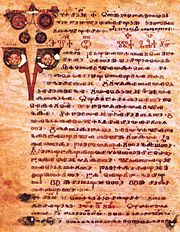
Codex Assemanius
Encyclopedia

Old Church Slavonic
Old Church Slavonic or Old Church Slavic was the first literary Slavic language, first developed by the 9th century Byzantine Greek missionaries Saints Cyril and Methodius who were credited with standardizing the language and using it for translating the Bible and other Ancient Greek...
canon evangeliary consisting of 158 illuminated parchment
Parchment
Parchment is a thin material made from calfskin, sheepskin or goatskin, often split. Its most common use was as a material for writing on, for documents, notes, or the pages of a book, codex or manuscript. It is distinct from leather in that parchment is limed but not tanned; therefore, it is very...
folios, dated to early 11th century. Manuscript is of Macedonian provenience of the First Bulgarian Empire
First Bulgarian Empire
The First Bulgarian Empire was a medieval Bulgarian state founded in the north-eastern Balkans in c. 680 by the Bulgars, uniting with seven South Slavic tribes...
.
Codex is named after its discoverer, Italian Jesuit scholar and Vatican librarian of Syrian origin Joseph Assemani, who discovered it and bought it in Jerusalem in 1736. His nephew donated it to the Vatican Library
Vatican Library
The Vatican Library is the library of the Holy See, currently located in Vatican City. It is one of the oldest libraries in the world and contains one of the most significant collections of historical texts. Formally established in 1475, though in fact much older, it has 75,000 codices from...
, where the codex is still kept today.
By content its an Aprakos
Aprakos
Aprakos is a kind of Gospel or Acts of the Apostles book, otherwise known as weekly or service Gospel . In aprakoses, the text is organized not in the natural order of books, but along with the weekly church readings starting from the Holy Week as used in the Eastern Orthodox Church...
(weekly, service) Gospel. It contains only pericope
Pericope
A pericope in rhetoric is a set of verses that forms one coherent unit or thought, thus forming a short passage suitable for public reading from a text, now usually of sacred scripture....
s, i.e. parts read in the church. At the end of the manuscript there is a Menologium
Menologium
Menologion , also written menology and menologe, is a service-book used in the Eastern Orthodox Church and those Eastern Catholic Churches which follow the Rite of Constantinople.From its derivation, menologium means "month-set"; in other words, a book arranged according to the months...
which mentions st. Demetrius, Theodosius, Clement and other Macedonian saints. The codex is held by many to be the most beautiful Old Church Slavonic book.
First to write about the codex was Mateo Karaman in his work Identitá della lingua letterale slava (manuscript, Zadar 1746). Manuscript was published by Franjo Rački
Franjo Racki
Franjo Rački was a Croatian historian, politician and writer. He compiled important collections of old Croatian diplomatic and historical documents, wrote some pioneering historical works, and was a key founder of the Yugoslavian Academy of Sciences and Arts.-Historian:Rački was born in Fužine,...
(Zagreb 1865, Glagolitic), Ivan Črnčić (Assemanovo izborno evangjelje; Rome 1878, published privately, transcribed in Latin), Josef Vajs and Josef Kurz (Evangeliář Assemanův, Kodex vatikánský 3. slovanský, 2. vols, Prague 1929, ČSAV, phototypical edition) - republished by Josef Kurz in 1966 in Cyrillic transcription. The newest Bulgarian edition is by Vera Ivanova-Mavrodinova and Aksinia Džurova from 1981 (Asemanievo evangelie; Sofia: Nauka i izkustvo), with fascimile reproductions.
Manuscript abounds with ligatures. Linguistic analysis has showed that the manuscript is characterized by frequent vocalizations of yer
Yer
The letter yer of the Cyrillic alphabet, also spelled jer or er, is known as the hard sign in the modern Russian and Rusyn alphabets and as er golyam in the Bulgarian alphabet...
s (ъ > o, ь > e), occasional loss of epenthesis, and ь is frequently replaced with hard ъ, esp. after r. These are the traits pointing to the Macedonian area, and are shared with Codex Marianus
Codex Marianus
The Codex Marianus ) is a Glagolitic fourfold Gospel Book from the beginning of eleventh century , which is , one of the oldest manuscript witnesses to the Old Church Slavonic language, one of the two fourfold gospels being part of the Old Church Slavonic canon, which contains a parts written by...
. Yers are also frequently omitted word-finally, and occasionally non-etymologically mixed (ь being written after k and g).
External links
- Codex Assemanius, scans of the newest 1981 fascimile edition
- Codex Assemanius transliterated in 7-bit ASCII, at the Corpus Cyrillo-Methodianum Helsingiense

